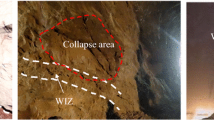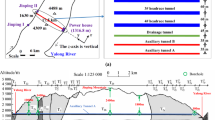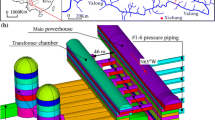Abstract
The disturbance of a rock mass by blasting or stress redistribution can significantly influence the overall performance of an underground excavation. The characteristics of excavation-damaged zones (EDZs) during the excavation of underground caverns at the Houziyan hydropower station in Sichuan Province, China, were investigated using various in situ tests. This study presents a comprehensive evaluation of the evolution of EDZs in the surrounding rock mass in the underground powerhouse caverns using microseismic (MS) monitoring and conventional testing methods, including multi-point extensometers, acoustic wave testing and borehole TV. First, by analyzing a series of conventional testing and MS monitoring results, the deformation and failure characteristics of the surrounding rock mass were determined. Next, the formation mechanisms of fractures in the surrounding rock mass subjected to excavation-induced unloading in the underground powerhouse caverns were determined. The relationships between the EDZs of the surrounding rock mass, crack evolution and construction status were then analyzed to investigate the crack formation, development and coalescence processes. Finally, the thicknesses of the EDZs were quantitatively determined, the relationships between the fracture evolution and construction progress were established, and the EDZ formation and evolution mechanisms were evaluated. The results not only provide direct data for geological exploration but also contribute to optimizing excavation design and support for analyzing the deformation behaviors of underground powerhouse caverns.



















Similar content being viewed by others
References
Andersson JC, Martin CD, Stille H (2009) The Aspo pillar stability experiment:part II—Rock mass response to coupled excavation- induced and thermal-induced stresses. Int J Rock Mech Min Sci 46(5):879–895
Bäckblom G, Martin CD (1999) Recent experiments in hard rocks to study the excavation response: Implications for the performance of a nuclear waste geological repository. Tunn Undergr Space Technol 14(3):377–394
Cai M, Kaiser PK (2005) Assessment of excavation damaged zone using a micromechanics model. Tunn Undergr Space Technol 20(4):301–310
Chen YF, Zheng HK, Wang M, Hong JM, Zhou CB (2015) Excavation-induced relaxation effects and hydraulic conductivity variations in the surrounding rocks of a large-scale underground powerhouse cavern system. Tunn Undergr Space Technol 49:253–267
Cheng LJ, Li ZG, Wang JS, Wang DK, Xia X (2014) Design report on reinforcement measures for surrounding rock mass in underground group caverns of Houziyan hydropower station along Dadu River. HydroChina Chengdu Engineering Corporation, Chengdu, p 163 (in Chinese)
Chigira M, Hariyama T, Yamasaki S (2013) Development of deep-seated gravitational slope deformation on a shale dip-slope: observations from high-quality drill cores. Tectonophysics 605:104–113
Fattahi H, Shojaee S, Ebrahimi Farsangi MA, Mansouri H (2013) Hybrid Monte Carlo simulation and ANFIS-subtractive clustering method for reliability analysis of the excavation damaged zone in underground spaces. Comput Geotech 54:210–221
Hoek E, Diederichs M (2006) Empirical estimation of rock mass modulus. Int J Rock Mech Min Sci 43(2):203–215
Hudson JA, Bäckström A, Rutqvist J, Jing L, Backers T, Chijimatsu M, Christiansson R, Feng XT, Kobayashi A, Koyama T, Lee HS, Neretnieks I, Pan PZ, Rinne M, Shen BT (2009) Characterising and modelling the excavation damaged zone in crystalline rock in the context of radioactive waste disposal. Environ Geol 57:1275–1297
Kelsall PC, Case JB, Chabannes CR (1984) Evaluation of excavation-induced changes in rock permeability. Int J Rock Mech Min Sci 21(3):123–135
Kim HM, Rutqvist J, Jeong JH, Choi BH, Ryu DW, Song WK (2013) Characterizing excavation damaged zone and stability of pressurized lined rock caverns for underground compressed air energy storage. Rock Mech Rock Eng 46:1113–1124
Kwon S, Lee CS, Cho SJ, Jeon SW, Cho WJ (2009) An investigation of the excavation damaged zone at the KAERI underground research tunnel. Tunn Undergr Space Technol 24(1):1–13
Li SJ, Feng XT, Li ZH (2011) In situ experiments on width and evolution characteristics of excavation damaged zone in deeply buried tunnels. Sci China Technol Sci 54(s1):167–174
Lu WB, Hu YG, Yang JH, Chen M, Yan P (2013) Spatial distribution of excavation induced damage zone of high rock slope. Int J Rock Mech Min Sci 64:181–191
Martini CD, Read RS, Martino JB (1997) Observations of brittle failure around a circular test tunnel. Int J Rock Mech Min Sci 34(7):1065–1073
Martino JB, Chandler NA (2004) Excavation-induced damage studies at the underground research laboratory. Int J Rock Mech Min Sci 41(8):1413–1426
Mathias J (2001) Determination of the damaged zone in quarries, related to aggregate production. Bull Eng Geol Environ 60:157–166
Pusch R, Stanfors R (1992) The zone of disturbance around blasted tunnels at depth. Int J Rock Mech Min Sci 29(5):447–456
Qi SW, Wu FQ, Yan FZ, Lan HX (2004) Mechanism of deep cracks in the left bank slope of Jinping first stage hydropower station. Eng Geol 73(1–2):129–144
Qi SW, Wu FQ, Zhou YD, Song YH, Gong MF (2010) Influence of deep seated discontinuities on the left slope of Jinping I Hydropower Station and its stability analysis. Bull Eng Geol Environ 69:333–342
Ramulu M, Chakraborty AK, Sitharam TG (2009) Damage assessment of basaltic rock mass due to repeated blasting in a railway tunnelling project—a case study. Tunn Undergr Space Technol 24:208–221
Read RS (2004) 20 years of excavation response studies at AECL’s Underground Research Laboratory. Int J Rock Mech Min Sci 41(8):1251–1275
Sato T, Kikuchi T, Sugihara K (2000) In-situ experiments on an excavation disturbed zone induced by mechanical excavation in Neogene sedimentary rock at Tono mine, central Japan. Eng Geol 56(1–2):97–108
Sheng Q, Yue ZQ, Lee CF, Tham LG, Zhou H (2002) Estimating the excavation disturbed zone in the permanent shiplock slopes of the Three Gorges Project, China. Int J Rock Mech Min Sci 39:165–184
Tsang CF, Bernier F, Davies C (2005) Geohydromechanical processes in the excavation damaged zone in crystalline rock, rock salt, and indurated and plastic clays-in the context of radioactive waste disposal. Int J Rock Mech Min Sci 42(1):109–125
Wang DK, Peng Q, Tang R, Deng JH, Qu HL (2007) Cause analysis of cracking of rock-bolted crane girder in an underground power ground. Chin J Rock Mech Eng 26(10):2125–2129 (in Chinese)
Wu FQ, Liu JY, Liu T, Zhuang HZ, Yan CG (2009) A method for assessment of excavation damaged zone (EDZ) of a rock mass and its application to a dam foundation case. Eng Geol 104:254–262
Wu FQ, Hu XH, Gong MF, Liu JY, Ren AW (2010) Unloading deformation during layered excavation for the underground powerhouse of Jinping I Hydropower Station, southwest China. Bull Eng Geol Environ 69:343–351
Xu NW, Li TB, Dai F, Li B, Zhu Y, Yang D (2015) Microseismic monitoring and stability evaluation for the large scale underground caverns of Houziyan hydropower station, southwest China. Eng Geol 188:48–67
Zhang JH, Hu ZX, Yang YT, Wei JB, Deng JH (2011) Acoustic velocity fitting and monitoring feedback analysis of surrounding rock loosing zone in underground powerhouse. Chin J Rock Mech Eng 30(6):1191–1197 (in Chinese)
Zhang CQ, Feng XT, Zhou H, Qiu SL, Wu WP (2013) Rockmass damage development following two extremely intense rockbursts in deep tunnels at Jinping II hydropower station, southwestern China. Bull Eng Geol Environ 72:237–247
Zhu ZQ, Sheng Q, Zhang YH, Li YF (2013) Research on excavation damage zone of underground powerhouse of Dagangshan hydropower station. Chin J Rock Mech Eng 32(4):734–739 (in Chinese)
Acknowledgments
The authors are grateful for the financial support from the National Program on Key Basic Research Project (No. 2015CB057903), National Natural Science Foundation of China (No. 51374149), Program for New Century Excellent Talents in University (NCET-13-0382) and the Excellent Young Scholar Plan of Sichuan University (No. 2015SCU04A32).
Author information
Authors and Affiliations
Corresponding author
Rights and permissions
About this article
Cite this article
Xu, N., Dai, F., Li, B. et al. Comprehensive evaluation of excavation-damaged zones in the deep underground caverns of the Houziyan hydropower station, Southwest China. Bull Eng Geol Environ 76, 275–293 (2017). https://doi.org/10.1007/s10064-016-0858-6
Received:
Accepted:
Published:
Issue Date:
DOI: https://doi.org/10.1007/s10064-016-0858-6




